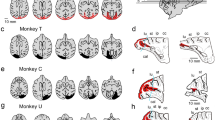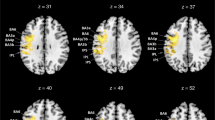Abstract
The exact role of the parietal lobe in spatial cognition is controversial. One influential hypothesis proposes that it subserves spatial perception1, whereas other accounts suggest that its primary role is to direct spatial movement2,3. For humans, it has been suggested that these functions may be divided between inferior and superior parietal lobes, respectively2,4. In apparent support of a purely perceptual function for the inferior parietal lobe (IPL), patients with lesions to this structure, particularly in the right hemisphere, exhibit unilateral spatial neglect (deficient awareness for the side of space opposite to that of their lesion)5. Here we show that patients with right IPL lesions also have a specific difficulty in initiating leftward movements towards visual targets on the left side of space. This motor impairment was not found in neglect patients with frontal lesions, contrary to previous proposals that motor aspects of neglect are particularly associated with anterior damage6,7,8,9. Our results suggest that the human IPL operates as a sensorimotor interface, rather than subserving only perceptual functions.
This is a preview of subscription content, access via your institution
Access options
Subscribe to this journal
Receive 51 print issues and online access
$199.00 per year
only $3.90 per issue
Buy this article
- Purchase on Springer Link
- Instant access to full article PDF
Prices may be subject to local taxes which are calculated during checkout




Similar content being viewed by others
References
Ungerleider, L. G. & Mishkin, M. in Analysis of Visual Behaviour (eds Ingle, D. J., Goodale, M. A. & Mansfield, R. J. W.) 549–586 (MIT Press, Cambridge, MA, (1982)).
Milner, A. D. & Goodale, M. A. The Visual Brain in Action (Oxford Univ. Press, Oxford, (1995)).
Snyder, L. H., Batista, A. P. & Andersen, R. A. Coding of intention in the posterior parietal cortex. Nature 386, 167–170 (1997).
Milner, A. D. in Parietal Lobe Contributions to Orientation in 3D Space (eds Thier, P. & Karnath, H.-O.) 3–22 (Springer, Heidelberg, (1997)).
Robertson, I. H. & Marshall, J. C. (eds) Unilateral Neglect: Clinical and Experimental Studies (Lawrence Erlbaum, Hillsdale, (1993)).
Mesulam, M-M. Acortical network for directed attention and unilateral neglect. Ann. Neurol. 10, 309–325 (1981).
Bisiach, E., Geminiani, G., Berti, A. & Rusconi, M. Perceptual and premotor factors of unilateral neglect. Neurology 40, 1278–1281 (1990).
Tegnér, R. & Levander, M. Through a looking glass. A new technique to demonstrate directional hypokinesia in unilateral neglect. Brain 114, 1943–1951 (1991).
Mattingley, J. B., Bradshaw, J. L. & Phillips, J. G. Impairments of movement initiation and execution in unilateral neglect—Directional hypokinesia and bradykinesia. Brain 115, 1849–1874 (1992).
Bisiach, E. Mental representation in unilateral neglect and related disorders: the twentieth Bartlett Memorial Lecture. Q. J. Exp. Psychol. 46A, 435–461 (1993).
Kinsbourne, M. Amodel for the mechanism of unilateral neglect of space. Trans. Am. Neurol. Assoc. 95, 143–145 (1970).
Posner, M. I., Walker, J. A., Friedrich, F. J. & Rafal, R. D. Effects of parietal injury on covert orienting of attention. J. Neurosci. 4, 1863–1874 (1984).
Riddoch, M. J. & Humphreys, G. W. The effect of cueing on unilateral visual neglect. Neuropsychologia 21, 589–599 (1983).
Heilman, K. M., Watson, R. T. & Valenstein, E. in Clinical Neuropsychology (eds Heilman, K. M. & Valenstein, E.) 243–293 (Oxford Univ. Press, New York, (1985)).
Mattingley, J. B. & Driver, J. in Parietal Lobe Contributions to Orientation in 3D Space (eds Thier, P. & Karnath, H.-O.) 309–338 (Springer, Heildeberg, (1997)).
Duncan, J. in The Cognitive Neurosciences (ed. Gazzaniga, M. S.) 721–733 (MIT Press, Cambridge, MA, (1995)).
Husain, M. & Kennard, C. Visual neglect associated with frontal lobe infarction. J. Neurol. 243, 652–657 (1996).
Husain, M., Shapiro, K., Martin, J. & Kennard, C. Abnormal temporal dynamics of visual attention in patients with spatial neglect. Nature 385, 154–156 (1997).
Damasio, H. & Damasio, A. R. Lesion Analysis in Neuropsychology (Oxford Univ. Press, New York, (1989)).
Mesulam, M.-M. Principles of Behavioural Neurology. Tests of Directed Attention and Memory (FA Davis, Philadelphia, (1985)).
Bushnell, M. C., Goldberg, M. E. & Robinson, D. L. Behavioural enhancement of visual responses in monkey cerebral cortex. I. Modulation in posterior parietal cortex related to selective visual attention. J. Neurophysiol. 46, 755–772 (1981).
Duhamel, J.-R., Colby, C. L. & Goldberg, M. E. The updating of the representation of visual space in parietal cortex by intended eye movements. Science 255, 90–92 (1992).
Andersen, R. A., Snyder, L. H., Bradley, D. C. & Xing, J. Multimodal representation of space in the posterior parietal cortex and its use in planning movements. Annu. Rev. Neurosci. 20, 303–330 (1997).
Graziano, M. S. A., Gross, C. G. & Fernandez, T. Acomparison of bimodal, visual-tactile neurons in parietal area 7b and ventral premotor cortex of the monkey brain. Soc. Neurosci. Abstr. 22, 398 (1996).
Husain, M. in Vision and Visual DysfunctionVol. 13 (ed. Stein, J. F.) 12–43 (Macmillan, Basingstoke, (1991)).
Perenin, M.-T. & Vighetto, A. Optic ataxia: a specific disruption in visuomotor mechanisms. I. Different aspects of the deficit in reaching for objects. Brain 111, 643–674 (1988).
Acknowledgements
We thank J. Wade and A. Rudd, and the staff and patients of the stroke units at Charing Cross Hospital and St. Thomas' Hospital, London. This research was supported by the Stroke Association and the Wellcome Trust. J.B.M. was supported by a National Health and Medical Research Council (Australia) Neil Hamilton Fairley Fellowship, and by AMRAD Australia.
Author information
Authors and Affiliations
Corresponding author
Rights and permissions
About this article
Cite this article
Mattingley, J., Husain, M., Rorden, C. et al. Motor role of human inferior parietal lobe revealed in unilateral neglect patients. Nature 392, 179–182 (1998). https://doi.org/10.1038/32413
Received:
Accepted:
Issue Date:
DOI: https://doi.org/10.1038/32413
This article is cited by
-
Comprehensive voxel-wise, tract-based, and network lesion mapping reveals unique architectures of right and left visuospatial neglect
Brain Structure and Function (2023)
-
Altered spontaneous neuronal activity and functional connectivity pattern in primary angle-closure glaucoma: a resting-state fMRI study
Neurological Sciences (2021)
-
Prism adaptation speeds reach initiation in the direction of the prism after-effect
Experimental Brain Research (2017)
-
Ready, set, point: The effects of alertness on prism adaptation in healthy adults
Experimental Brain Research (2015)
-
Enhanced parietal cortex activation during location detection in children with autism
Journal of Neurodevelopmental Disorders (2014)
Comments
By submitting a comment you agree to abide by our Terms and Community Guidelines. If you find something abusive or that does not comply with our terms or guidelines please flag it as inappropriate.



